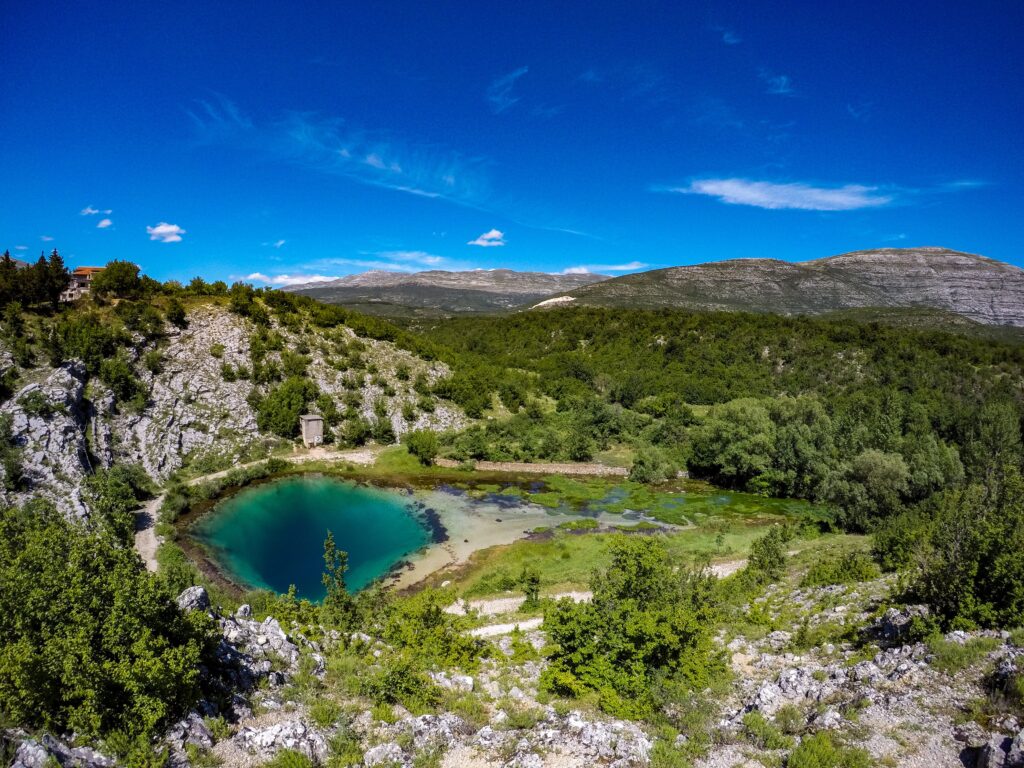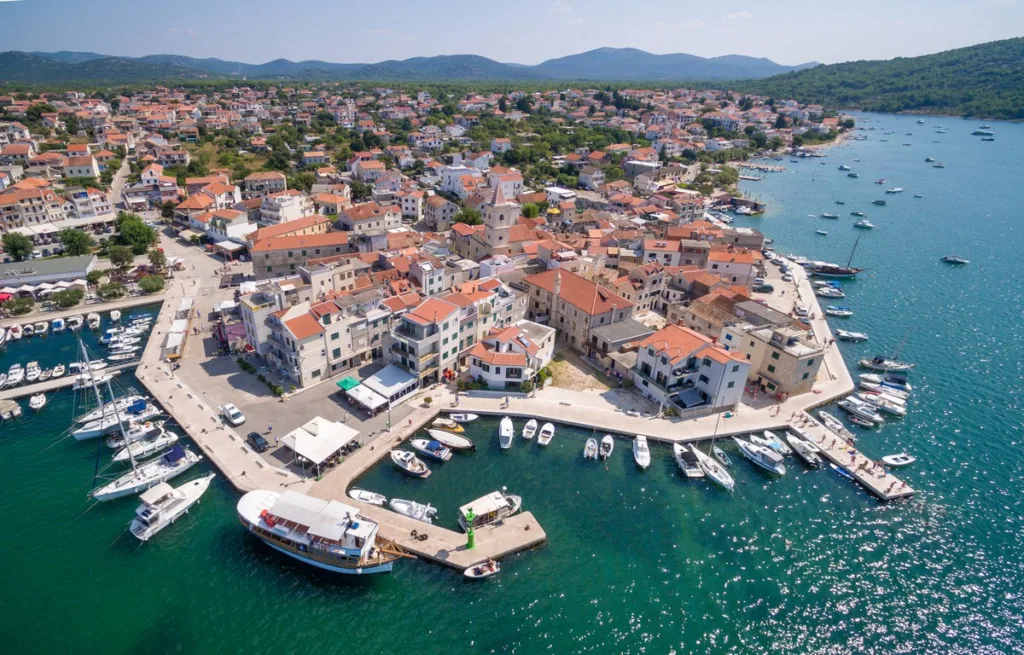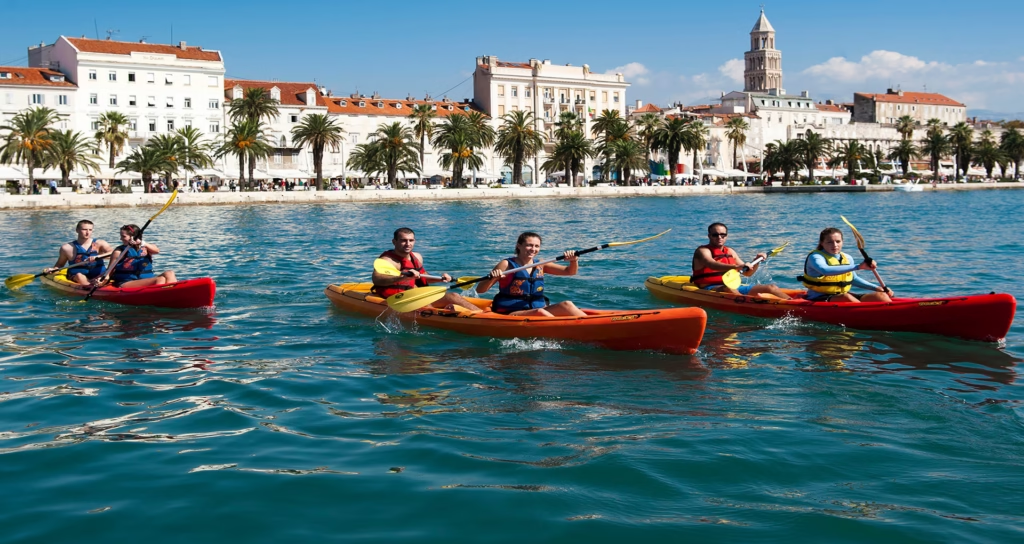Dinara Nature Park, Croatia’s youngest protected area, is a wild and untamed world of rugged mountains, karst fields, and hidden springs. Established in 2021, it spans more than 63,000 hectares across Split-Dalmatia and Šibenik-Knin counties. The park shelters Croatia’s highest summit, Sinjal, the turquoise Eye of the Earth spring at the Cetina River source, and a cultural landscape shaped by centuries of grazing and transhumance. For hikers, climbers, and nature lovers, Dinara Nature Park is a journey into the heart of the Dalmatian hinterland.

Table of Contents
ToggleWhy Dinara Nature Park Matters
Croatia’s Newest Protected Area
When Dinara Nature Park was proclaimed in 2021, it became the country’s youngest nature park and the second largest by area. Its boundaries include the Dinara, Troglav, and Kamešnica mountains, the upper course of the Cetina River, and fertile karst fields where agriculture and herding still thrive. Eleven Natura 2000 sites overlap the park, underscoring its European-level ecological importance.
Sinjal: Croatia’s Roof
The jewel of Dinara is Sinjal peak, at 1,831 meters. Known simply as Dinara peak, it is the highest point in Croatia. From its summit, visitors can admire sweeping views of the Adriatic coast, the inland plateaus of Bosnia and Herzegovina, and the jagged ridges of the wider Dinaric Alps. On clear days, the panorama stretches from Velebit in the north to the distant peaks of Montenegro.
A Living Karst Landscape
The park protects more than 1,000 species of plants, including many endemics adapted to harsh limestone terrain. Endangered animals such as the Balkan meadow viper live here, along with wolves, chamois, and golden eagles. Large predators like bear and lynx occur in the wider Dinaric Alps region, but sightings inside the park itself are very rare. Human activity has shaped the environment too: centuries of shepherding carved out pastures and meadows that are now vital habitats.
Top Things to Do in Dinara Nature Park
Hike to Sinjal Peak
The most rewarding adventure is hiking to Sinjal. Two classic routes lead to the summit:
Glavaš trail: Begins near Kijevo and Glavaš Fortress ruins. The path ascends through rocky slopes and meadows, passing Martinova košara shelter before reaching the summit. Allow 4–5 hours of steady climbing.
Brezovac route: Starting near Knin, this route is longer but less steep. Many hikers stay overnight at Brezovac mountain hut before continuing to the top. The hut offers basic facilities but must be reserved in advance.
Both routes are demanding. Water sources are scarce, and the bura wind can be fierce. Good preparation is essential.
Marvel at the Cetina River Source
At the base of the Dinara lies one of the most striking springs in Europe, the Eye of the Earth. This bottomless-looking, turquoise karst spring gives birth to the Cetina River, which flows to the Adriatic at Omiš. The site is protected, and swimming is forbidden, but visitors can enjoy unforgettable views from the lookout above.
Step Into History at Knin Fortress
Knin Fortress dominates the town below and is one of Croatia’s largest and most significant fortifications. It witnessed the coronation of medieval Croatian kings and later played a role in Ottoman and Venetian conflicts. Today it is open to visitors, offering sweeping views of Dinara and the surrounding valleys.
Chase Waterfalls at Krčić
Above the Krka River source stands the Krčić Waterfall, also called Topoljski buk. This seasonal cascade tumbles from limestone cliffs, thundering in spring and after heavy rainfall, before often drying up in summer. Combined with the Krka spring below, it forms a rare karst phenomenon.
Cool Off at Peruća Lake
Peruća Lake, the third largest in Croatia, lies south of Vrlika. This reservoir, framed by mountains, is popular for kayaking, stand-up paddling, and swimming. Its calm waters and peaceful setting make it an excellent base for relaxation after exploring Dinara.
Hiking Trails and Mountain Huts
Glavaš to Sinjal
The Glavaš trail offers a direct and scenic climb. Along the way, hikers pass the medieval Glavaš Fortress ruins, grassy plateaus, and the Martinova košara shelter, a basic refuge near the ridge. The path is waymarked, but hikers should be fit and well-prepared.
Brezovac to Sinjal
This longer route begins at Brezovac mountain hut, located at 1,050 meters. Hikers often spend the night here, breaking the ascent into two days. The trail is less steep than Glavaš but covers greater distance. Brezovac is run by a mountaineering club and has 42 beds.
Other Trails
Beyond Sinjal, Dinara offers a network of paths linking ridges, valleys, and pastures. Sections of the international Via Dinarica trail cross the park, connecting it with mountains in Bosnia and Herzegovina. Hikers can also explore less demanding routes near Vrlika and Knin.
Trail Safety
Dinara is a true wilderness. Water is scarce, weather changes quickly, and bura winds are notorious. Certain remote areas still contain landmines, a legacy of war. Stick to marked trails and always check conditions before setting out.
Practical Planning
Getting There
By car: Dinara is best accessed by road. Knin and Vrlika are the main gateways. From Split or Šibenik, the drive takes about 1.5 hours.
By train: Limited services connect Split and Knin, offering a scenic but slower route.
By bus: Buses link Split, Šibenik, Knin, and Vrlika, though schedules may vary.
Best Time to Visit
Spring and autumn bring cooler temperatures, ideal for hiking. Wildflowers bloom in spring, while autumn offers clear views and fewer crowds. Summer is hot, with little shade, while winter often brings snow to Sinjal.
Park Rules
Wild camping is not allowed; use official huts or nearby accommodation.
Swimming at the Cetina source is prohibited.
Fires are strictly forbidden in summer.
Respect local grazing practices and avoid disturbing livestock.
Safety Considerations
Most marked trails are safe, but always follow signage. Croatia is working towards being mine-free by 2026, yet hikers should avoid wandering off paths. Carry plenty of water, food, and proper gear.
Wildlife and Nature
Flora
Dinara’s vegetation zones range from Mediterranean shrubs at lower altitudes to alpine meadows near Sinjal. In spring, orchids and other wildflowers color the slopes. Rare plants adapted to limestone thrive in the cracks of the karst.
Fauna
Dinara is home to wolves, chamois, and a variety of birds of prey such as golden eagles and peregrine falcons. The Balkan meadow viper is an iconic reptile of the grasslands. Larger predators like bears and lynx are present in the wider Dinaric Alps, but actual sightings inside Dinara Nature Park are uncommon.
Karst Wonders
Karst features define Dinara: caves, sinkholes, dolines, and disappearing rivers. The Cetina and Krka Rivers both rise here, making the park vital for regional water resources. Cavers and geologists will find countless underground passages still being explored.
Cultural and Historical Heritage
Fortresses and Ruins
The slopes of Dinara are dotted with medieval fortresses, monasteries, and villages now partly abandoned. Glavaš Fortress and Knin Fortress stand out, but smaller ruins tell stories of centuries of border conflicts and pastoral life.
Shepherding Traditions
For generations, shepherds led flocks across Dinara’s pastures. This seasonal movement, known as transhumance, shaped both the land and local culture. Stone huts, sheepfolds, and dry walls remain visible reminders of this way of life.
Local Cuisine
After a day of hiking, try traditional dishes in Knin and Vrlika. Specialties include lamb roasted under a peka (iron dome), homemade cheeses, and river trout from the Cetina. These flavors are part of the region’s identity.
Where to Stay
Knin
Knin offers hotels, guesthouses, and restaurants. Its fortress, museum, and proximity to Brezovac hut make it an ideal base for exploring northern Dinara.
Top Rated Stays in Knin
🔍Apartman Stela
Score: 9.7 (115 reviews)
One-bedroom apartment on a quiet street with balcony and mountain views. Guests praise spotless cleanliness and value. Best for couples or small families wanting a self-contained base near Knin Castle.
Neighborhood: near Knin Castle
Facilities: parking, Wi-Fi, kitchen, washing machine, air conditioning, balcony
Why it stands out: Consistently high cleanliness and value scores🔍Apartment ZORA
Score: 9.6 (113 reviews)
One-bedroom apartment with balcony and city/fortress views. Guests highlight the central location and thoughtful host. Best for a convenient city stay close to restaurants and the Fortress.
Neighborhood: city centre, fortress views
Facilities: parking, Wi-Fi, airport shuttle, kitchen, washing machine, air conditioning, balcony
Why it stands out: Central spot with balcony views toward Knin Fortress🔍Apartman Noel Knin
Score: 9.9 (143 reviews)
Spacious apartment with terrace, garden and BBQ. Reviews praise the welcoming host and great location near shops and the station. Best for families or groups seeking space and outdoor amenities.
Neighborhood: near shops and train station
Facilities: parking, Wi-Fi, family rooms, terrace, garden, BBQ
Why it stands out: Exceptional scores across cleanliness, comfort and value🔍CHEZ Marthe, Organic Farm stay
Score: 9.4 (146 reviews)
Studio apartment in a quiet suburban setting with garden. Guests rave about the generous breakfast and friendly host. Best for travelers who enjoy a peaceful farm-style vibe near town.
Neighborhood: suburban Knin, near waterfalls
Facilities: breakfast, parking, Wi-Fi, kitchen, terrace, garden
Why it stands out: Breakfast consistently praised as a highlight🔍Jasna1
Score: 9.2 (168 reviews)
Rooms and studios in a central location with easy access to the castle and station. Guests note super-fast Wi-Fi and convenience. Best for budget-friendly, in-town stays and short stopovers.
Neighborhood: city centre, near castle and train station
Facilities: parking, Wi-Fi (39 Mbps), family rooms, non-smoking rooms
Why it stands out: Reliable central base with fast Wi-Fi
Vrlika
Vrlika is smaller and quieter, but perfect for travelers who want to combine hiking with time at Peruća Lake. Family-run apartments and rural houses provide authentic hospitality.
Top Rated Stays in Vrlika
🔍Mare
Score: 9.6 (109 reviews)
Peaceful B&B in the countryside hamlet of Maovice with rooms featuring balconies and home-style meals. Guests praise the warm hospitality and tranquil setting. Best for nature-seekers and road-trippers.
Neighborhood: Maovice, Vrlika
Facilities: balcony, parking, Wi-Fi
Why it stands out: Excellent breakfasts and dinners with a homely touch.🔍Apartman ANA
Score: 9.8 (126 reviews)
Air-conditioned apartment with terrace and garden views in a quiet rural location. Guests highlight the peaceful surroundings and welcoming hosts. Best for couples or small families.
Neighborhood: Kosore, Vrlika
Facilities: terrace, patio, garden, parking, Wi-Fi
Why it stands out: Consistently praised for its serene location and hospitality.🔍Rooms Leda
Score: 9.2 (154 reviews)
Motel-style stay with garden and terrace just outside Vrlika. Guests enjoy mountain-view patios, easy parking, and a quiet environment. Best for short stays and budget travelers.
Neighborhood: Podosoje, near Vrlika
Facilities: garden, terrace, parking, Wi-Fi
Why it stands out: Peaceful setting and friendly host noted by guests.🔍Holiday home Marija
Score: 9.0 (105 reviews)
Rustic holiday home near Lake Peruća with balcony and lake views. Guests mention the calm atmosphere and homely details. Best for couples or small groups seeking a lakeside retreat.
Neighborhood: Ježević, near Lake Peruća
Facilities: balcony, air conditioning, Wi-Fi
Why it stands out: Quiet lake setting praised for relaxation.🔍Rooms and Apartments Budiša
Score: 9.5 (166 reviews)
Country house on the lake in Garjak offering rooms and apartments. Guests enjoy the lakeside location, free bikes, and homemade meals. Best for relaxed lake holidays.
Neighborhood: Garjak, by the lake
Facilities: bikes, garden, parking, Wi-Fi, lake access
Why it stands out: Lakeside setting with home-cooked food praised by visitors.
Mountain Huts and Shelters
Brezovac Hut: Managed by mountaineers, with 42 beds and a rustic atmosphere. Booking in advance is essential.
Martinova košara Shelter: A simple wooden refuge on the Glavaš trail. It provides shelter but no services.
Responsible Travel Tips
Pack out all litter and leave nature untouched.
Do not disturb wildlife or pick rare plants.
Avoid plastic bottles; refill water containers where possible.
Support local communities by staying in family accommodations and trying local food.
Share trails respectfully with other hikers and shepherds.
FAQs
How long does it take to climb Sinjal peak?
From Glavaš, allow 4–5 hours to the summit. From Brezovac, the ascent can be split into two days with an overnight stay in the hut.
Can you swim at the Eye of the Earth?
No, swimming is strictly prohibited. The Cetina source is a protected hydrological monument and must be respected.
Are there still landmines in Dinara Nature Park?
Yes, some remote areas remain dangerous. However, all marked hiking trails are considered safe. Never leave the waymarked paths.
Is there an entrance fee for Dinara Nature Park?
Currently, there is no general entrance fee. Specific attractions such as Knin Fortress charge separate tickets.
What is the best season to visit Dinara?
Spring and autumn are best for hiking. Summer is hot and dry, while winter often brings snow and icy conditions on the summit.
What gear should I bring?
Sturdy boots, layered clothing, plenty of water, and navigation tools are essential. For longer hikes, bring food and a sleeping bag if staying at Brezovac hut.
Conclusion
Dinara Nature Park is more than a mountain; it is a symbol of Croatia’s wild heritage. From the summit of Sinjal to the depths of the Eye of the Earth, the park offers raw adventure and cultural discovery. It remains one of the best places to experience the untamed beauty of the Dalmatian hinterland.
Disclosure: This page may contain affiliate links. This means that we get a small commission from any purchase you make, at no additional cost to you!

